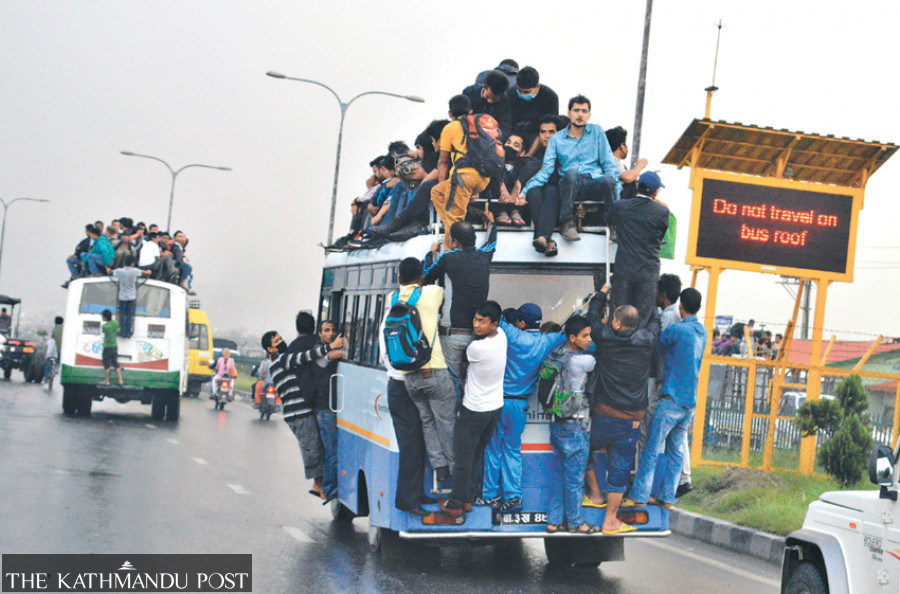
Rajmi Paudel uses a public bus while commuting to his New Road office and back every day. He boards the bus from Dhital Chowk, in Tarakeshwar Municipality Ward 5, where he has been living with his family in a rented accommodation.
On Sunday, when Paudel, 41, got on the bus, it was as crowded as usual. “Even though the bus was packed with passengers, the conductor was forcefully asking them to cram in when a commuter shouted there was no space,” said Paudel, who works in a corporate office.
“To my surprise, the conductor caught him and beat him black and blue while uttering foul language,” said Paudel, adding that the man beaten up was heading to the Tribhuvan University Teaching Hospital at Maharajgunj to meet a sick relative.
The man got off at Machhapokhari and took another bus.
Paudel shared his frustration of using public transport. “First, it’s really hard to get a seat. Second, the way the conductor behaved makes travel very difficult,” he said.
Like Paudel, Nitisha Gautam, 25, a Master’s first year student at Tribhuvan University, who regularly boards the Nepal Yatayat from Pepsicola to Balkhu, says the commute is a nightmare.
“It takes me over an hour to reach Balkhu, and the conductor keeps passengers packed like sardines. You feel alive only after you come out of the bus,” said Gautam. She said it’s really difficult to avoid the harassment inside the vehicle.
“It’s really difficult for women to avoid an inappropriate touch in a crowded bus,” said Gautam, who lives with her two elder brothers who are school teachers.
Gautam said even though she can afford to buy a scooter, she does not have the confidence to ride in a crowded city where drivers are reckless.
Although the agenda of improving public transport emerges every local election, once mayors reach the seat of power, they do nothing. Kathmandu’s unmanaged traffic is no exception.
It’s a problem not only for Paudel and Gautam. Hundreds of passengers who need to board public vehicles from major bus stations such as Ratnapark, Nepal Airlines, Koteshwar and Kalanki are forced to take overcrowded buses in the absence of viable options.
When the Post contacted Krishna Harmi Maharjan, the mayor of Tarakeswar Municipality, regarding Sunday’s incident in his area, he said he was sorry to know about the trouble.
“It’s true that I had made a commitment to improving public transport in my area, but I am more worried about such issues,” said Maharjan.
Not only during Maharjan’s stint, in the 2017 elections too, former mayor Bidya Sundar Shakya had vowed to bring about reforms in public transportation. However, half a decade later, the service has become more chaotic in Kathmandu. Even though Balendra Shah has been elected the mayor, he has not done anything to address traffic jams and other problems in the city.
“We are aware of the issue in Kathmandu, although it's the traffic police that need to address such problems. The City is ready to provide the required help to the traffic police,” said Nabin Manandhar, spokesperson for the City.
“I will also raise this issue with mayor Balendra Shah,” said Manandhar.
According to Kathmandu Valley Traffic Police Office, the number of vehicles that ply the Valley roads at present is 1.75 million. Just a year ago, traffic police data showed the number to be 1.4 million.
According to traffic police, around 20 percent of total vehicles running in Kathmandu Valley are in public service.
Deputy Inspector General Mira Chaudhary, who has been working proactively to address the traffic problem in the Valley, said that only the traffic police can’t solve the present problem.
“In the case of harassment and misbehaviour inside the vehicle, passengers can directly call 103 and lodge a complaint, but with regard to the increasing traffic jams, and keeping passengers more than the capacity, we alone can’t solve the problem,” said Chaudhary.
She said last week when traffic police were keeping an eye on Nepal Yatayat, it had issued tickets to 27 Nepal Yatayat staff for violating traffic rules in two days.
On average, traffic police book some 3,000 traffic rule breachers every day, and from November 17 to December 15, it sent 60 licences to the Department of Transport Management, recommending their suspension for six months.
“We are trying our best to build up a system, but unless all the stakeholders work together, this problem can’t be solved,” said Chaudhary. “I request the transport operators, local governments, and other stakeholders to come together to solve the malpractices.”












